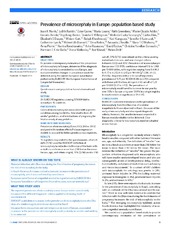| dc.contributor.author | Morris, Joan K. | en_US |
| dc.contributor.author | Rankin, Judith | en_US |
| dc.contributor.author | Garne, Ester | en_US |
| dc.contributor.author | Loane, Maria | en_US |
| dc.contributor.author | Greenlees, Ruth | en_US |
| dc.contributor.author | Addor, Marie-Claude | en_US |
| dc.contributor.author | Arriola, Larraitz | en_US |
| dc.contributor.author | Barisic, Ingeborg | en_US |
| dc.contributor.author | Bergman, Jorieke E.H. | en_US |
| dc.contributor.author | Csaky-Szunyogh, Melinda | en_US |
| dc.contributor.author | Dias, Carlos | en_US |
| dc.contributor.author | Draper, Elizabeth S. | en_US |
| dc.contributor.author | Gatt, Miriam | en_US |
| dc.contributor.author | Khoshnood, Babak | en_US |
| dc.contributor.author | Klungsøyr, Kari | en_US |
| dc.contributor.author | Kurinczuk, Jennifer J. | en_US |
| dc.contributor.author | Lynch, Catherine | en_US |
| dc.contributor.author | McDonnell, Robert | en_US |
| dc.contributor.author | Nelen, Vera | en_US |
| dc.contributor.author | Neville, Amanda J. | en_US |
| dc.contributor.author | O'Mahony, Mary T. | en_US |
| dc.contributor.author | Pierini, Anna | en_US |
| dc.contributor.author | Randrianaivo, Hanitra | en_US |
| dc.contributor.author | Rissmann, Anke | en_US |
| dc.contributor.author | Tucker, David | en_US |
| dc.contributor.author | Verellen-Dumoulin, Christine | en_US |
| dc.contributor.author | de Walle, Hermien E.K. | en_US |
| dc.contributor.author | Wellesley, Diana | en_US |
| dc.contributor.author | Wiesel, Awi | en_US |
| dc.contributor.author | Dolk, Helen | en_US |
| dc.date.accessioned | 2017-05-04T12:09:04Z | |
| dc.date.available | 2017-05-04T12:09:04Z | |
| dc.date.issued | 2016 | |
| dc.Published | Morris JK, Rankin J, Garne E, Loane M, Greenlees R, Addor M, Arriola L, Barisic I, Bergman JE, Csaky-Szunyogh M, Dias C, Draper ES, Gatt M, Khoshnood B, Klungsøyr K, Kurinczuk, Lynch C, McDonnell R, Nelen V, Neville AJ, O'Mahony MT, Pierini A, Randrianaivo H, Rissmann A, Tucker D, Verellen-Dumoulin C, de Walle HE, Wellesley D, Wiesel A, Dolk H. Prevalence of microcephaly in Europe: Population based study. BMJ (British Medical Journal). 2016;354:i4721 | eng |
| dc.identifier.issn | 1756-1833 | |
| dc.identifier.uri | https://hdl.handle.net/1956/15779 | |
| dc.description.abstract | Objectives: To provide contemporary estimates of the prevalence of microcephaly in Europe, determine if the diagnosis of microcephaly is consistent across Europe, and evaluate whether changes in prevalence would be detected using the current European surveillance performed by EUROCAT (the European Surveillance of Congenital Anomalies). Design: Questionnaire and population based observational study. Setting: 24 EUROCAT registries covering 570 000 births annually in 15 countries. Participants: Cases of microcephaly not associated with a genetic condition among live births, fetal deaths from 20 weeks’ gestation, and terminations of pregnancy for fetal anomaly at any gestation. Main outcome measures: Prevalence of microcephaly (1 Jan 2003-31 Dec 2012) analysed with random effects Poisson regression models to account for heterogeneity across registries. Results: 16 registries responded to the questionnaire, of which 44% (7/16) used the EUROCAT definition of microcephaly (a reduction in the size of the brain with a skull circumference more than 3 SD below the mean for sex, age, and ethnic origin), 19% (3/16) used a 2 SD cut off, 31% (5/16) were reliant on the criteria used by individual clinicians, and one changed criteria between 2003 and 2012. Prevalence of microcephaly in Europe was 1.53 (95% confidence interval 1.16 to 1.96) per 10 000 births, with registries varying from 0.4 (0.2 to 0.7) to 4.3 (3.6 to 5.0) per 10 000 (χ2=338, df=23, I2=93%). Registries with a 3 SD cut off reported a prevalence of 1.74 per 10 000 (0.86 to 2.93) compared with those with the less stringent 2 SD cut off of 1.21 per 10 000 (0.21 to 2.93). The prevalence of microcephaly would need to increase in one year by over 35% in Europe or by over 300% in a single registry to reach statistical significance (P<0.01). Conclusions: EUROCAT could detect increases in the prevalence of microcephaly from the Zika virus of a similar magnitude to those observed in Brazil. Because of the rarity of microcephaly and discrepant diagnostic criteria, however, the smaller increases expected in Europe would probably not be detected. Clear diagnostic criteria for microcephaly must be adopted across Europe. | en_US |
| dc.language.iso | eng | eng |
| dc.publisher | BMJ | eng |
| dc.rights | Attribution CC BY-NC | eng |
| dc.rights.uri | http://creativecommons.org/licenses/by-nc/4.0/ | eng |
| dc.title | Prevalence of microcephaly in Europe: Population based study | en_US |
| dc.type | Peer reviewed | |
| dc.type | Journal article | |
| dc.date.updated | 2017-02-14T09:37:24Z | |
| dc.description.version | publishedVersion | en_US |
| dc.rights.holder | Copyright 2016 The Author(s) | |
| dc.identifier.doi | https://doi.org/10.1136/bmj.i4721 | |
| dc.identifier.cristin | 1394833 | |
| dc.source.journal | BMJ (British Medical Journal) | |

